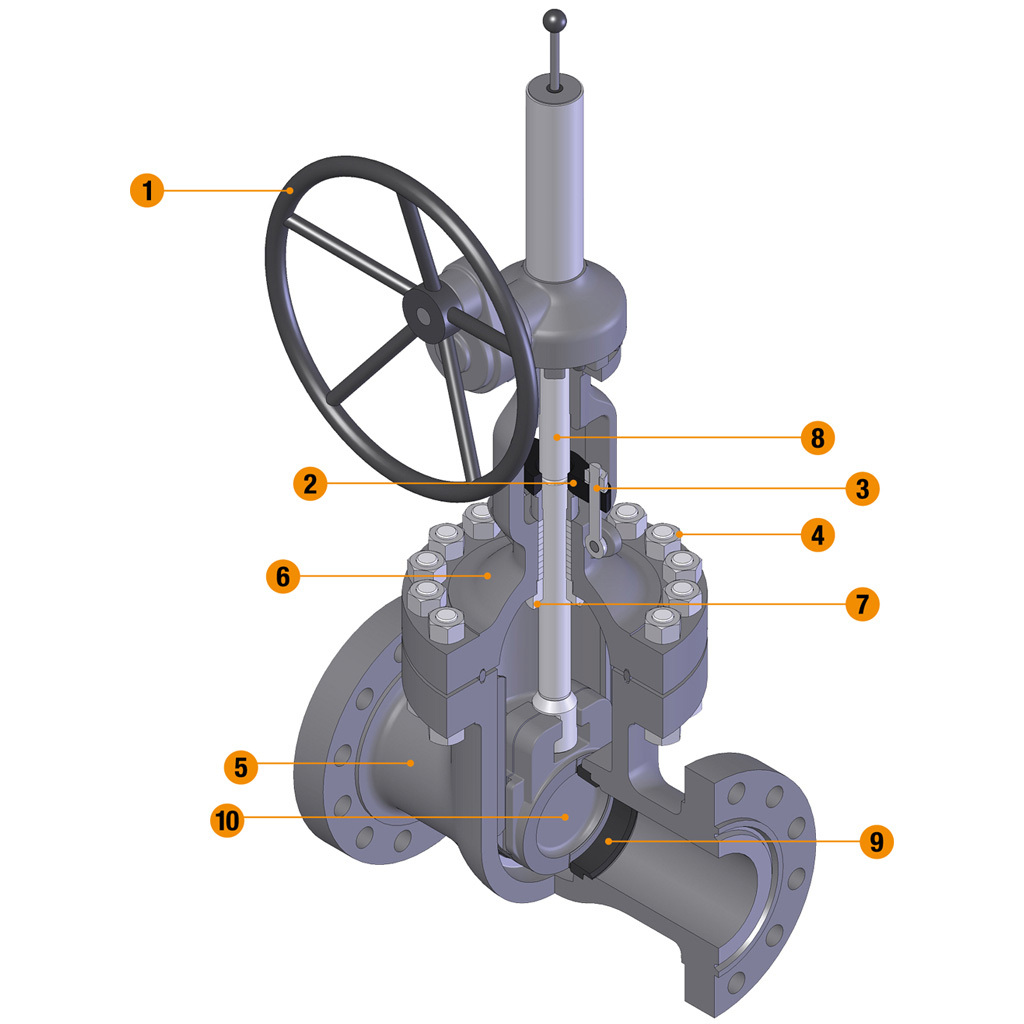GLAND AND FLANGE
They are in forged steel and are normally supplied in two pieces, self aligning design to permit the gland to descend parallel to the stem even if the eyebolts are unevenly tightened.


A lantern ring is supplied upon request, in this case the stuffing box shall be drilled, tapped and fitted with an 1/4” NPT plug or grease fitting.
Gate valves are best fit for vertical stem / horizontal flow installation. Special cases can be evaluated and developed on request.
The spoked handwheel is fabricated from steel pipe. The hub is coupled to the yoke sleeve by means of a key. Larger valves are equipped with a bevel or spur gear gearbox unit.
They are in forged steel and are normally supplied in two pieces, self aligning design to permit the gland to descend parallel to the stem even if the eyebolts are unevenly tightened.
The forged steel gland bolts are of the eyebolt type which can be swung outward for ease of gland repacking. They are fixed to the bonnet by hinge pins.
Bonnet studs and nuts are manufactured from alloy steel to the relevant ASTM standard. The body to bonnet connection is designed according to ASME VIII DIV 1 standard.
The body is in carbon or stainless steel and is available in many other CRA. It is carefully designed for total reliability and simple maintenance. The basic dimension, i.e. wall thickness, face to face and flanges comply with the relevant API and ASME standards. The body-to-bonnet flange is circular, except in the Class 150 where it is oval. The body-to-bonnet joint are flat face on Class 150 valves, male-and-female on Class 300 and ring joint on Class 600 and above. The body is basically supplied with renewable seats. Bosses are provided for drain taps or by-pass piping.The internal surfaces in contact with the fluid can be fully lined or cladded for improved corrosion or erosion resistance.
As the body, the bonnet is in carbon or stainless steel and is available in many other CRA. It is machined to accept yoke sleeve and incorporates a stuffing box sized in accordance with the API standard. Lifting lugs can be provided integrally cast on the bonnet surface.
The bonnet bushing or backseat is part of the valve trim. Its design allows valve repacking without valve’s bleeding or draining. Hardfacing can be provided on stem seating surface.
The stem is part of the trim and is available in a wide range of material in accordance to API 600 or customer’s requirements. The stem is provided with a T-shaped head. A ground backseat is provided to ensure a perfectly tight seal to the stuffing box when the valve is fully open. The stem is highly finished in order to minimize friction and prevent damage to the packing. The thread is trapezoidal ACME type. All the stem sizes comply with the API 600 standard.
Welded-in seat rings are supplied as a standard. The rings are part of the trim of the valve. They can be externally threaded and internally notched for easy installation and dismantling. Special attention is given to the seating surfaces which are ground and lapped for a tight seal.
The wedge is the main part of the trim. It is forged or cast in carbon or stainless steel and also available in CRA material. It is normally supplied as the solid wedge type. It is connected to the stem by means of a T-shaped joint. The guides on each side of the wedge are machined. Special care is given to the seating surfaces which are ground and lapped, integral or hardfaced. A cladding or lining can be applied to the wedge to improve its resistance against erosive and corrosive environments. For improved seating and unseating easiness, it can be machined with the flexible option.